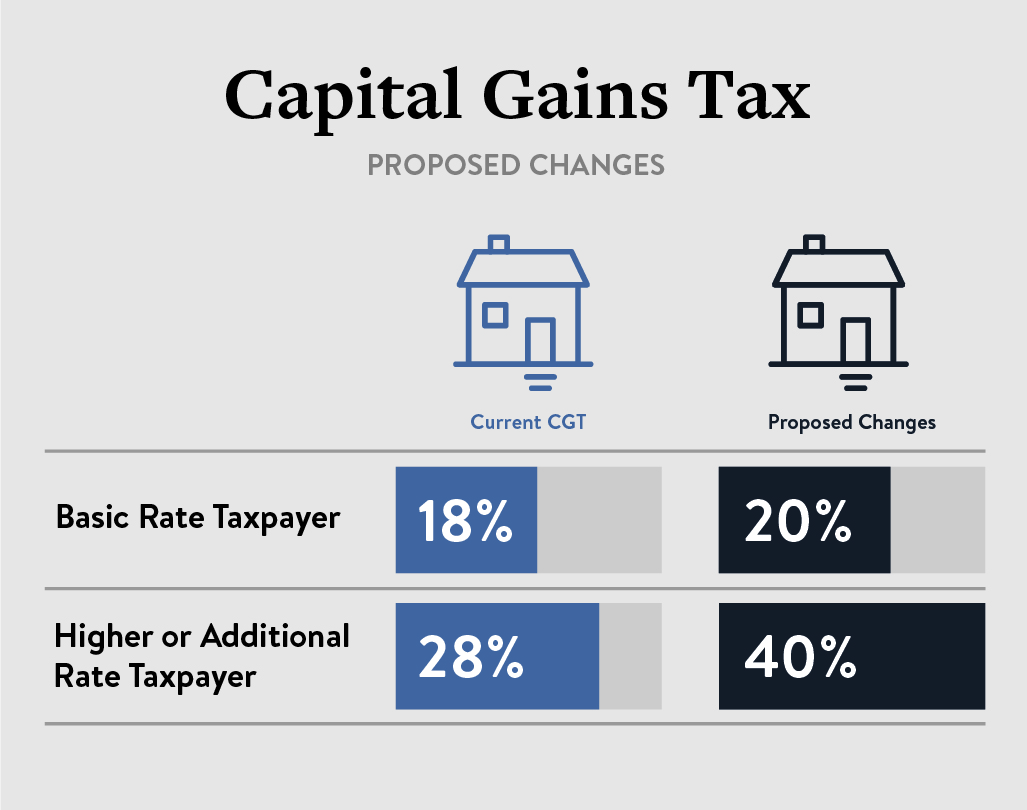What is Capital Gains Tax and how is it calculated for Buy to Let properties?
If you’re a landlord and you decide to sell your Buy to Let property, it’s more than likely you will need to pay Capital Gains Tax on the amount that property has gone up in value by, since you purchased it.
The amount of Capital Gains Tax (CGT) paid is relative to the amount of profit you make, for example:
If you purchased a £200,000 Buy To Let property and you sell it after it has increased in value to £250,000, your profit is £50,000 and it is this figure on which your Capital Gains Tax bill is calculated.
Under the current system, higher-rate or additional-rate taxpayers pay Capital Gains Tax at 28% on profits made from the sale of residential property, whilst basic-rate taxpayers pay 18%.
You can make a profit of £12,300 on the sale of a Buy To Let property before you’re liable to CGT and any money you spend on improving the property or fees associated with selling, such as estate agent or solicitor fees, can be deducted from your profit, thereby lowering your overall CGT liability.
There are some exemptions to Capital Gains Tax paid on property sales:
- Principal Private Residence relief means you don’t pay CGT on profit made by the sale of the property you live in.
- Also, if you co-habited with your tenants, i.e. rented out a room in your property, you’re eligible for a £40,000 tax free lettings relief allowance before you pay CGT.
- If you’ve ever lived in your Buy to Let property, you only pay CGT for the time it was occupied solely by a tenant(s).
Why Might The Government Make Changes To Capital Gains Tax?
After so many years of the Government working hard to reduce spending and ‘bring down the deficit’ the Office for Budget Responsibility (OBR), has estimated that the UK will borrow more money this financial year than any other since WWII in its efforts to fight Covid-19.
Tax increases are predicted to be the only way the Government can pay for the £394bn Covid-19 bill the UK has accumulated during the last 12 months.
Measures put in place by the Government to tackle the Coronavirus pandemic will earn the Exchequer less money in tax this year – unemployed and furloughed staff paying less income tax, businesses paying less tax on reduced profits and with entire industries temporarily closed across the country, it will also result in the Government receiving less in VAT.
Some economists predict that the cost of the crisis can be covered by borrowing alone, but others disagree, believing that tax increases, whilst politically unpopular, are almost inevitable. However, increased taxation directly contradicts the Conservative manifesto laid out for the 2019 General Election which promised not to raise VAT, Income Tax or National Insurance. Making changes to any of the ‘big three’ now, could be extremely uncomfortable for a Government keen to steady the ship in the wake of the virus.
All the signals point to Capital Gains Tax being on the Government’s agenda for increasing revenue.
What are the proposed changes to the Capital Gains Tax system?
A recent report from the Office of Tax Simplification (OTS) laid out a number of potential changes to more closely align Capital Gains Tax with an individuals Income Tax rate, thereby significantly increasing the amount of CGT for higher rate and additional rate tax payers.
Most UK taxpayers do not currently pay Capital Gains Tax because their profit is typically under £12,300 or they inhabit the property sold, meaning it’s landlords, business owners and those who participate in share schemes who account for most of the CGT paid in the UK. The proposed changes look to decrease the annual tax free allowance from £12,300 to between just £2,000-£4,000, which will vastly increase the reach of CGT, thus making it payable by many more people within the UK.
Capital Gains Tax is an important source of revenue for the Exchequer – raising £9 billion in 2017-18, it is paid by a relatively small number of people (just 265,000 annually) which is why it has been identified as an area for potential growth and income for the Government. To put this in context, Income Tax raises £180bn per year and is paid by 32 million people in the UK annually.

Example Capital Gains Tax Calculation For Higher Rate Tax Payer
Current CGT Payable On Buy To Let Sale
Purchase Price: £200,000
Buy To Let Sale Price: £250,000
Capital Gain: £50,000
Capital Gains Tax Free Allowance: £12,300
Capital Gains Tax Payable: £10,556 (28% £37,700)
Proposed CGT Payable On Buy To Let Sale
Purchase Price: £200,000
Buy To Let Sale Price: £250,000
Capital Gain: £50,000
Capital Gains Tax Free Allowance: £3,000*
Capital Gains Tax Payable: £18,800 (40% of £47,000)
*Estimated figure based on an average of the guidance for the introduction of a £2,000 – £4,000 tax free allowance.
Advice for landlords thinking of selling?
With a potential recession on the horizon as we enter 2021, there may be investors who have a requirement to free up some of the cash tied up in their Buy to Let portfolios. Of course the proposed changes we’ve discussed here are not guaranteed to take effect, so we’re not suggesting that immediate action needs to be taken.
However, should the proposed changes be passed into UK Law, for landlords who are currently considering selling properties that have made considerable capital gains in recent years, they would have a significant impact on the cost of the disposal of Buy to Let investments – costing more than double the current rate for higher rate and additional rate tax payers.
In the first instance, we would encourage you to take professional advice before making any long term decisions about your Buy To Let portfolio, but if you are minded to sell, taking action before the proposed changes to Capital Gains Tax are included in the forthcoming budget, could potentially save you a small fortune.








